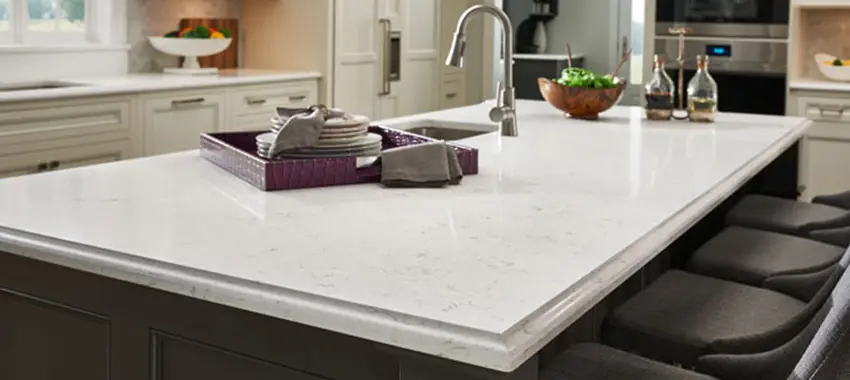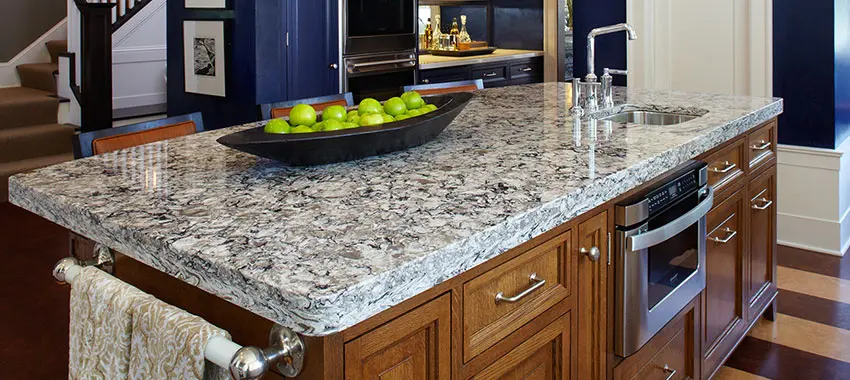Dec
What Are The Best Quartz Countertops Edge Profiles?
- 2023
- FlintStoneTops
Selecting countertop materials can be hard, but the edges are also really crucial to think about. Here are some amazing edge options that will look spectacular on quartz countertops.
Pencil Edge Profile
A pencil edge profile is also called a straight edge and it’s one of the most common edges in quartz countertops. They’re simple, they look clean and minimal and if you’re not sure about a certain style of edge, then this one is a go-to for a lot of people.
It is just like it sounds. A pencil edge is pointed from the top and bottom and the side profile of it looks literally like a slab. This is a wonderful edge design to go for if you’re looking for something minimal and effortless. It’s going to give your countertop or island that element of crisp simplicity.
Eased Edge Profile
This is also like a straight or pencil edged profile, but it’s softened just a touch. The side profile of this edge looks rounded from both of the edges and it’s a lot more subtle than a very obvious pencil edge. This is great if you have kids who bump into things a lot and pencil edges can be quite dangerous because the edges of the countertops are sharp and pointy.
Moreover, eased edges are shaved down to look rounded so they are not only less dangerous than their pointy counterparts, but they can also reduce the chances of breaking and chipping upon impact, so that’s pretty amazing.
Bullnose Profile
Some might think that bullnose and eased edges are the same, but there is a slight difference that plays an important role. Bullnose edges are also rounded and don’t have any pointed edges protruding outwards, but the overall edge is also rounded unlike eased edges where only the edges are rounded and the extremity of the countertop is straight.
The roundness of the bullnose edge gives the countertops a lot more integrity and it prevents premature chipping and breaking because the shape is a lot more forgiving. You can’t go wrong with a bullnose countertop and with quartz, this edge profile is really easy to fabricate, so you’ll be in for a treat.
The only downside to this edge design is the fact that it doesn’t let things stay on top of the surface like water or other fluids. With straight or eased edges, because of the straight extremity, the water or fluid will stop at the edge, whereas in bullnose edges, the water will slide down the rounded extremity. So that is something that you will need to keep in mind.
Half Bullnose Profile
This edge is a cross between a pencil edge and a bullnose edge. The top of the edge is rounded and soft whereas the bottom of the edge is pointy just like a normal edge. This edge is a bit more classy and intricate if you’re looking for a bit of change from those common edge designs, but still want simplicity and ease to shine through.
This edge design can be easily fabricated on strong and durable quartz countertops and you will fall in love with the results. This edge profile looks specifically good on countertops with a darker color, but the choice is ultimately up to you.
Ogee Profile
This kitchen island edge design has a beautiful flair to it and this might just be your new favorite edge for quartz countertops. The top of the countertop edge is shaved into a “C” shape and it droops down into a half bullnose formation. And at the end, the edge is protruding out like a pointed edge.
So, all in all, this edge is a combination of three unique edge designs, but the result is just as wonderful. It’s elegant and regal and it gives off that luxurious vibe when fabricated on a countertop or island.
Beveled Profile
If you’re looking for angular edges because that’s what you prefer, then you can certainly choose a beveled edge profile. The side of this edge is very futuristic. It starts with a slope that’s about 45 degrees and it goes all the way to the bottom of the edge thickness.
This edge is beautiful and it looks amazing on quartz countertops, but you can get it done on any other countertop material as well and the look will be as lovely as ever. If rounded and pointed edges are not your thing, then you certainly want to give this edge profile a go.
Half Bevel Profile
This is also a cross between the normal bevel and the pointed edge design. This edge design is a lot softer than a normal bevel, but it still has that sharp angular look that people know and love. So, you won’t be missing out on anything.
The top of the edge slopes down at a 45-degree angle, but this time, instead of going all the way to the bottom, the slope stops halfway and then it drops down into a pointed edge formation. This combination looks stunning if you want a more prominent design.
Summit Profile
In looks, this design can be similar to a half bevel, but it’s so much more than that when you do a side-by-side comparison. A summit edge starts with an angular steep at about 45 degrees and it stops at 1/4th of the thickness. After that, the design is straight and it goes all the way down in a pencil edge style. In some cases, at 3/4th of the thickness, the design can change again and mirror the top.
Boulder Edge Profile
This design will be highlighted beautifully if you have thicker countertops, so it will look stunning on a kitchen island. The boulder design is something similar to a rounded edge, but it’s double layers.
The design starts with a “C” shaped curve and then the edge drops down into a rounded bullnose formation, and after that, there’s another more protruding rounded bullnose and this is what gives this edge a wonderful layered effect that is absolutely beautiful.
If you have thicker countertops, then certainly consider this edge profile because you will be wowed. Because of the layering, this design doesn’t look the best on thin countertops though.
Basin Edge Profile
The basin edge profile is a wonderful combination of soft and edgy. The edge of the countertop starts with a dragged “C” shape. The curve is not as pronounced and it looks somewhat straight with a slight curve. As the curve ends, the edge tapers up a bit before descending in a rounded tip and it looks absolutely beautiful on darker colored countertops. You can also go for this design with lighter-colored countertops, but the grooves and intricacies will be prominent in darker colors. You will have to see the pictures for yourself to understand the hype of this design.
Laminated
This rather a protective coat on top of the entire quartz slab to preserve its shine and beauty. This can also add to the shine of your quartz countertop. Moreover, this feature can be used along with any edge profile you want.
Conclusion
If you are considering quartz countertops, then definitely check out these edge designs. They will add a distinct character to your countertops. So, get in touch with quartz countertop contractors Rockville to find out which edge profiles they offer.



